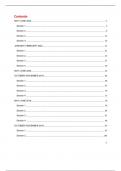Contents
MAY/ JUNE 2022........................................................................................................................................... 3
Section 1 ..................................................................................................................................................... 3
Section 2 ..................................................................................................................................................... 8
Section 3 ................................................................................................................................................... 12
Section 4 ................................................................................................................................................... 16
JANUARY/ FEBRUARY 2022 ................................................................................................................... 21
Section 1 ................................................................................................................................................... 21
Section 2 ................................................................................................................................................... 23
Section 3 ................................................................................................................................................... 27
Section 4 ................................................................................................................................................... 30
MAY/ JUNE 2020......................................................................................................................................... 32
OCTOBER/ NOVEMBER 2019 ................................................................................................................. 60
Section 1 ................................................................................................................................................... 60
Section 2 ................................................................................................................................................... 67
Section 3 ................................................................................................................................................... 70
Section 4 ................................................................................................................................................... 72
MAY/ JUNE 2019......................................................................................................................................... 78
Section 1 ................................................................................................................................................... 78
Section 2 ................................................................................................................................................... 85
Section 3 ................................................................................................................................................... 87
Section 4 ................................................................................................................................................... 90
OCTOBER/ NOVEMBER 2018 ................................................................................................................. 97
Section 1 ................................................................................................................................................... 97
Section 2 ................................................................................................................................................. 105
1
, Section 3 ................................................................................................................................................. 107
Section 4 ................................................................................................................................................. 111
MAY/ JUNE 2018....................................................................................................................................... 115
Section 1 ................................................................................................................................................. 115
Section 2 ................................................................................................................................................. 123
Section 3 ................................................................................................................................................. 125
Section 4 ................................................................................................................................................. 130
2
,MAY/ JUNE 2022
Section 1
A group of tourists is visiting Cape Town and is about to board their tour bus when they
hear a loud screeching of tyres. One of them, Mr Candida, turns towards the sound with
his camera in hand, and photographs a red Ferrari that runs a red traffic light and crashes
into another vehicle, a white minibus taxi, that was crossing the intersection. Mr
Candida immediately writes down everything that he observed. The driver of the Ferrari,
Mr Speedy, is subsequently charged with reckless and negligent driving and Mr Candida
will be the only witness in the case. Fully answer the following questions, with reference
to decided cases, applicable examples, and relevant legislation:
1.1 How must the court approach Mr Candida’s evidence? (10)
The cautionary rule with respect to a single witness is not limited to a situation where
only one person gives evidence for the prosecution. There is usually more than one
point in issue in any particular case, and if only one witness is available to testify on a
particular point in issue, that witness will be a single witness.
Section 208 of the Criminal Procedure Act 51 of 1977, states that an accused may be
convicted of any offence on the single evidence of a competent witness, this makes it
possible for a court to convict a person or to give judgment against a party on the
evidence of a single witness alone. If the court is satisfied that the evidence given by
the single witness is satisfactory, it may, but need not, regard that evidence sufficient
to convict.
3
, In the case of R v Mokoena, the court stated that the evidence of a single witness
can be relied on when it is clear and satisfactory in every material respect. In
instances where the witness has conflicting interests to, or is biased against, the
accused, it cannot be relied upon. In the case of R v T, the court interpreted the
statement from the Mokoena case to mean that the remarks should not be raised to
an absolute rule of law.
In the case of S v Webber, the court outline what the approach of a court should be
in the case of a single witness. It found that firstly, the evidence of a single witness
should be approached with caution, but such evidence does not need to be rejected
just because the single witness happens to have an interest in the case or shows
bias. The correct approach would be to assess the intensity of the bias and establish
its importance in view of the evidence as a whole. Secondly, the court found that a
conviction is possible on the evidence of a single witness, but he must be credible
and the evidence should be approached with caution. Appropriate consideration
should be given to factors which affirm/ detract from the credibility of the witness. The
probative value of the evidence of a single witness should not be equated with that of
several witnesses.
It must be noted that there is no formula to apply when considering the credibility of a
single witness. The degree of caution, which should be applied to the testimony of a
single witness, may also be increased by other factors.
1.2 Mr Candida is an avid photographic enthusiast who does not believe in using
digital cameras and who develops his own photographs. He has been asked to
produce his photographs in court. Discuss the nature of this evidence and then
explain the requirements for admissibility and mention possible exceptions.
4




